By Jose Pellicer, Head of Investment Strategy, Real Estate and Richard Gwilliam, Head of Property research at M&G Investments
The turmoil in the banking sector which erupted in March sparked a degree of panic lasting into April, as central banks found themselves on heightened alert. Arguably, the tumult seems to have settled down since then, like the calm after the storm. In today’s climate, weather can be unpredictable – are the underlying stresses behind the turbulence still bubbling away, and could they escalate into a bigger storm yet to come?
In real estate, most markets have experienced stormy weather since the middle of last year. The UK seems to have led in this respect, experiencing significant valuation falls ahead of other markets, but signs of possible stabilisation more recently. Could this be a case of bad weather taking time to reach different geographies? In this mid-year view, we ask: is the worst of the banking turmoil over, and how concerned should we be about any impact on the property market that may lie ahead?
Banking crisis? This time is different… so far….banks in better shape now
The troubles emanating from the banking sector in recent months have reignited lingering memories of the devastation wrought by the Global Financial Crisis (GFC), as well as the Savings and Loans Crisis of the 1980s and 90s. Compared to those previous crises, however, things appear to be a bit different this time round.
Financial deregulation in the US in the early 1980s, which exacerbated the Savings and Loans Crisis, and the years leading up to the GFC were characterised by surges in risky lending, sparking concerns over the quality of banks’ loan books, and precipitating bank failures and fears of systemic collapse.
Such a surge in risky lending has been largely absent in recent years. The GFC remains too fresh in people’s minds for lenders to have relaxed underwriting standards over the last decade, and leverage within the real estate sector has, on the whole, appeared to remain relatively restrained.
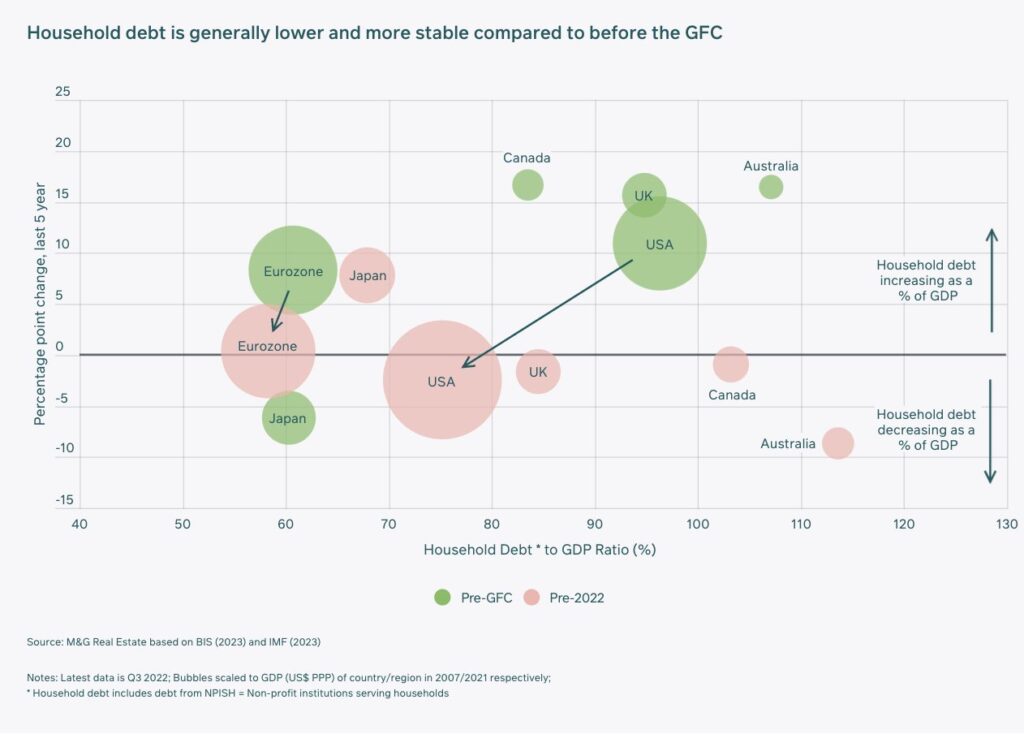
Tighter regulations, swift and robust policy response
With lessons learned from the GFC, European banks in particular are more tightly regulated and better capitalised today.
Policymakers have also been very much on the front foot in responding to the recent banking sector turmoil. Aware that a ‘fear factor’ contagion could lead to bank runs and a domino effect bringing down more banks, they have stepped in to stem the panic, for example by signalling that bank deposits will be guaranteed.
This support has helped reassure markets, and may already be preventing any contagion effect. Of course, confidence can be a fragile thing, so escalation into a full banking/financial crisis still cannot be ruled out.
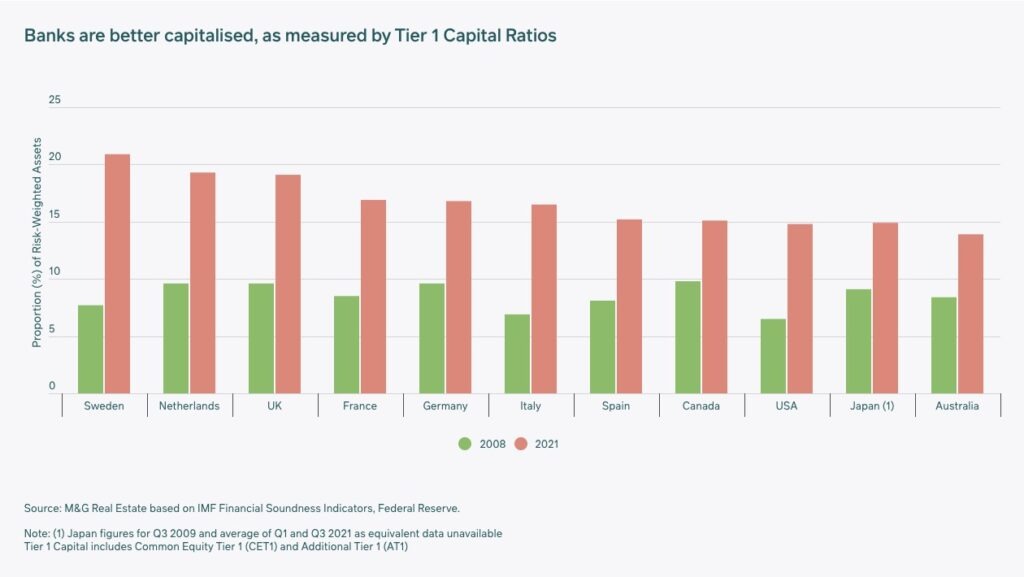
Less risk, but risk all the same – Rapid rate rises have repercussions!
After a decade of ‘free’ money, it’s impossible for interest rates to rise as quickly as they have from such low levels without consequences for the financial system.
Banks have been learning that when rates rise, they may get an asset/liability mismatch, particularly if there are differences in the duration of cashflows from each given differential maturities of loans previously agreed at lower rates, compared to higher interest rates which may have to be made for newer deposits.
These issues have so far manifested primarily among smaller US banks which lent to tech companies, though there is a clear sense of risk in the wider banking sector owing to interest rate rises, a fall in the value of banks’ asset bases, and depositor nervousness, particularly regarding banks which have asset cashflows with some form of weakness (or perceived weakness) in them.
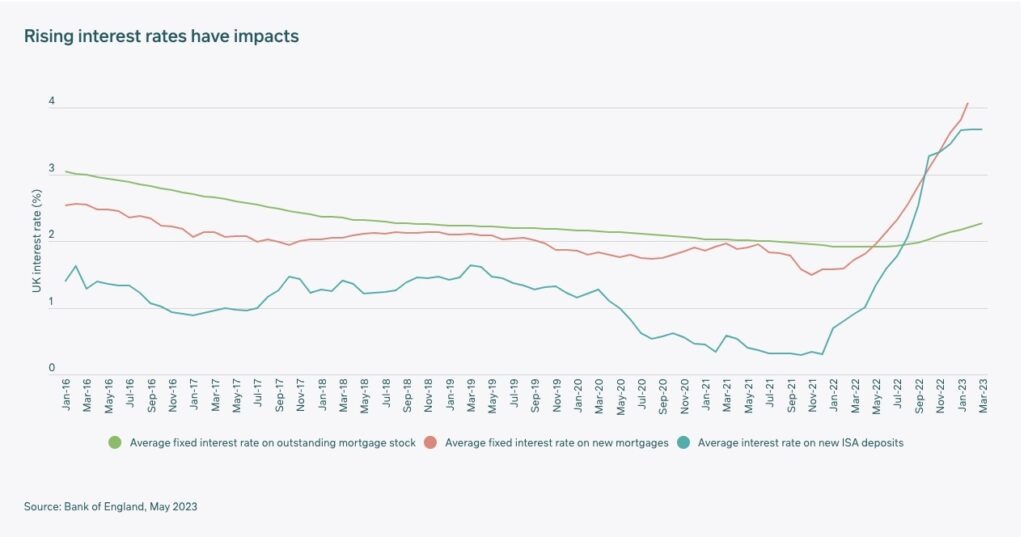
Pockets of risk threaten an outsized impact
Real estate risk factors are not equally distributed globally. There are areas of stress within the system which are more likely to cause problems, including the outsized lending by mid-sized US banks to commercial real estate asset owners and developers.
Following a loosening of regulation for mid-sized banks in 2018, the scrutiny on many of these banks is more limited – and so the full extent of the risk is unknown. This compares to the Eurozone, where the threshold for regulation is much lower and any risk of failure appears more contained.
There are likely other weaknesses lurking in the system beyond real estate. Non-financial corporate debt across the US and Europe (including the UK) is now around 90% of combined GDP, having tripled since 2000, though around three quarters of this is fixed for the long-term and therefore is not imminently vulnerable to rising rates. Higher interest rates are likely to eat into corporate profits and scale back investment outlay, weakening economic growth prospects.
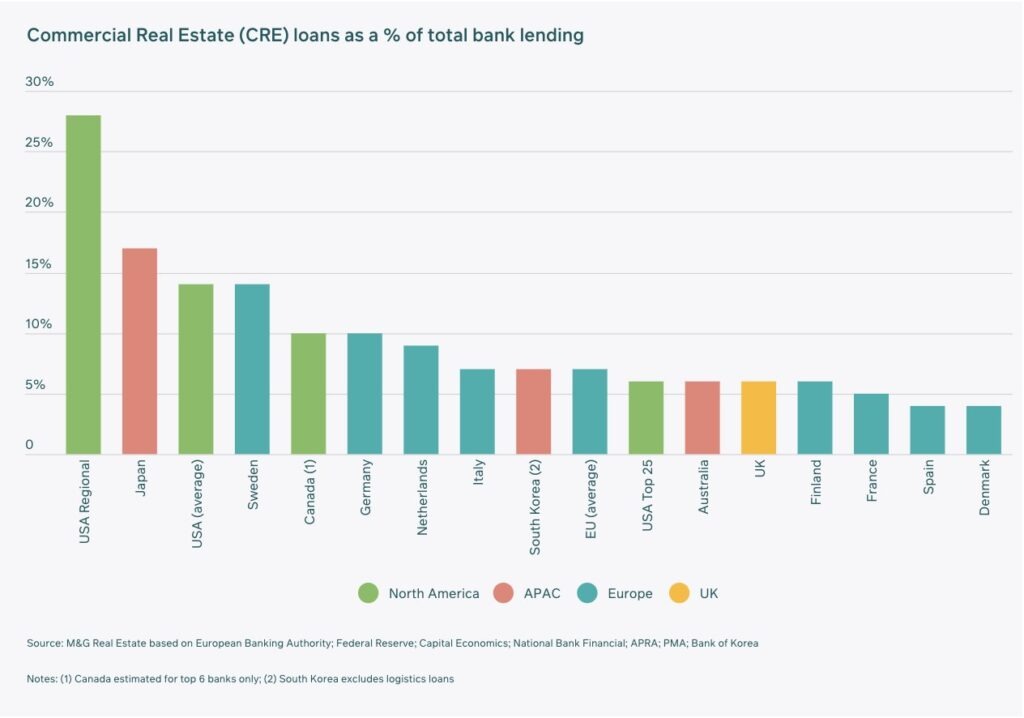
Central bank policy dilemma – tackle inflation or save the system?
Inflationary pressures have caused widespread dramatic tightening in monetary policy.
The repercussions for the banking sector of such tightening have prompted central banks to carefully consider what they must prioritise: price stability (stable inflation), or financial stability (ensuring a functioning financial system).
In the short-term, if there is a trade-off to be made, we believe central banks will prioritise financial stability, potentially accepting a slightly higher trajectory of inflation.
Interest rate expectations have been shifting, aided by inflation itself showing signs of moderation – although it seems likely to remain elevated and above target in the near-term.
While many central banks have continued hiking rates in recent months, we could now be at, or close to the peak. Given the rapidity of the hiking cycle, some estimates suggest over half of the impact on the real economy from rate rises has yet to be felt. Looking forward, the prospect of interest rate cuts, even before the end of the year, looks possible.
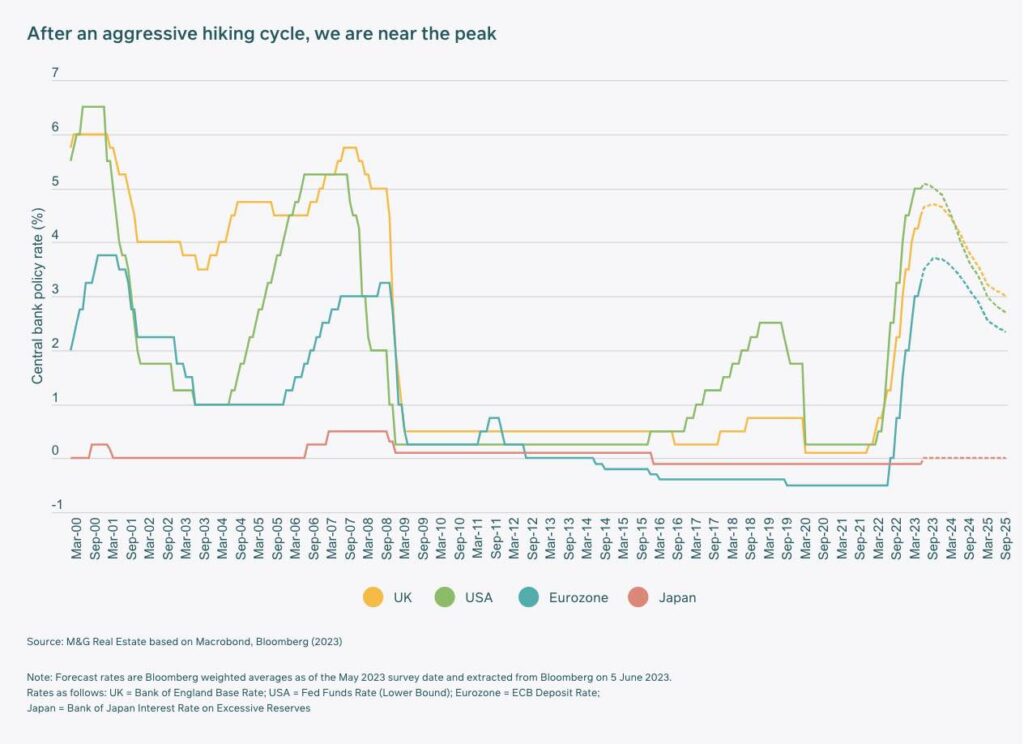
Tighter credit conditions for real estate – even without further base rate hikes
The banking sector at large is now acutely aware of its own fragility, so banks are likely to be restricting their own lending behaviour.
Even with more moderate base rate expectations, a conservative and cautious approach by banks could still equate to proxy monetary tightening.
A higher cost of debt and reduced credit availability – both for new loans and for the refinancing of existing debt-backed investments – will hold back the real estate investment market.
Tighter credit conditions would, at the very least, hamper any property market capital value growth/recovery to a degree by restricting downwards pressure on property yields. And in many markets, at least for some assets, such conditions are likely to result in further upwards pressure on yields, potentially extending capital declines.
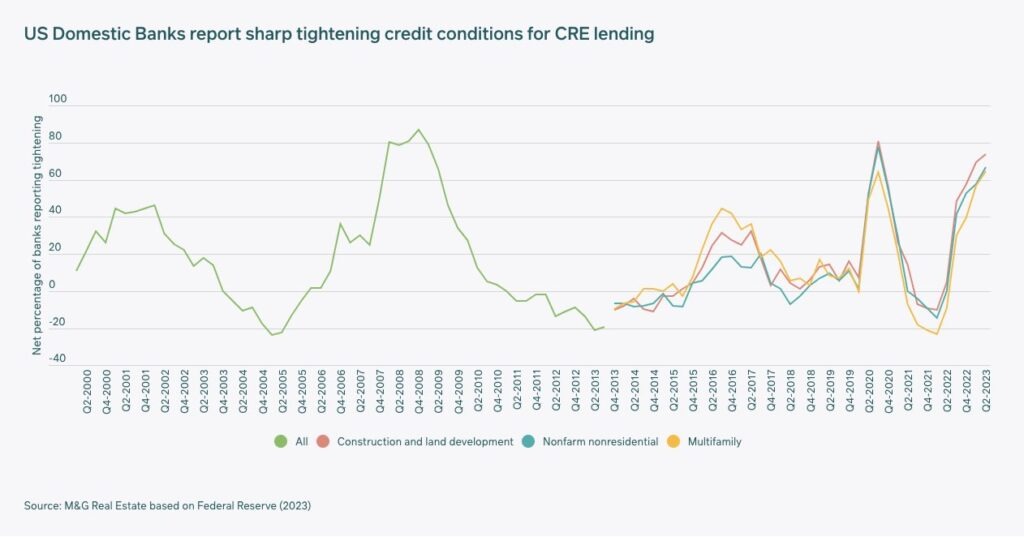
Financing constraints and risk aversion to intensify polarisation – Reduction in investor demand for riskier property
The uncertainty wrought by the banking sector turmoil means lenders and investors are likely to operate with a greater degree of risk aversion, by being cautious in what they decide to proceed with, and by demanding higher compensation when they do take on risk.
Riskier secondary property assets tend to be more reliant on debt-backed buyers who typically use leverage to help generate the higher returns required for moving up the risk spectrum.
Given the reduction in availability of financing and the more expensive cost of debt, particularly for riskier lending, with reduced demand from debt-backed property investors at any given level of asset pricing, these higher-risk, poorer-quality real estate assets are likely to bear the brunt of any further softening of yields/prices.
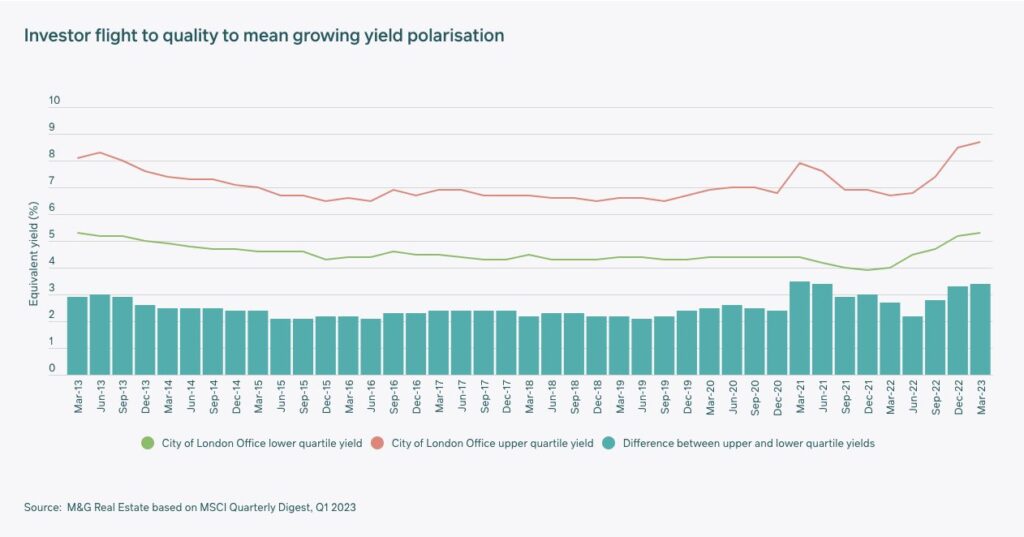
Polarisation exacerbated by less capital to improve assets
A ‘flight to quality’ is likely to result in relative resilience for core, prime property with secure cashflows (particularly where repricing of the asset has already occurred).
Poorer quality assets, on the other hand, are more vulnerable to occupational market risks like vacancy, particularly amidst a relatively fragile economic environment.
The ability of such assets to improve their performance is likely to be hindered through less capital being available for the required expenditure on refurbishment or redevelopment.
It’s possible that this trend could delay the investment in upgrading ESG credentials for ‘brown’ assets – not a great outcome for making progress on the path to net zero carbon. The ‘green premium’ is set to remain a feature of the market.
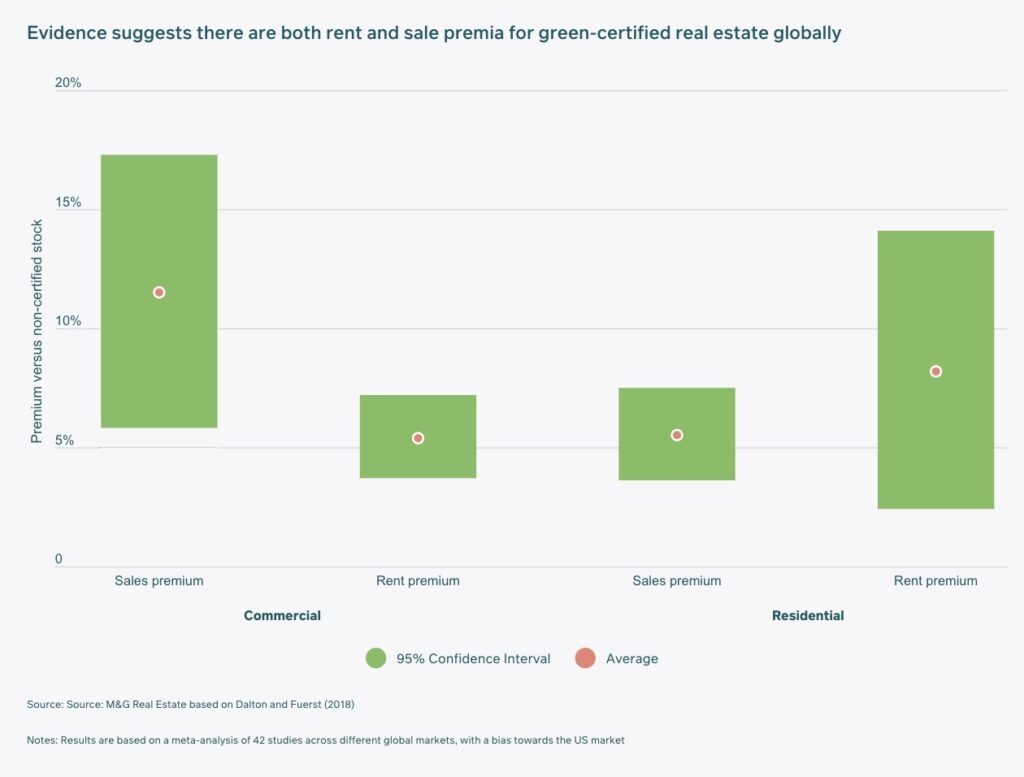
Real estate lending trends – challenges and opportunities – A wave of distress?
Interest coverage ratios. Loan-to-Value (LTV) ratios. With materially higher interest rates now, and with property assets in many markets having seen their values fall recently, both of these ratios for existing loans against real estate are at risk of being on the wrong side of terms either previously agreed or available today.
This could lead to distress, particularly when it comes to refinancing requirements due in the period ahead, which could result in forced sales as distressed assets in this situation are put on the market if financing is not viable.
This is likely to lead to further weakening of pricing for such assets as it exacerbates the supply/demand differential in the investment market, particularly for weaker/riskier stock. However, it may also bring about opportunity for investors to acquire assets cheaply and employ value-add strategies to boost returns.
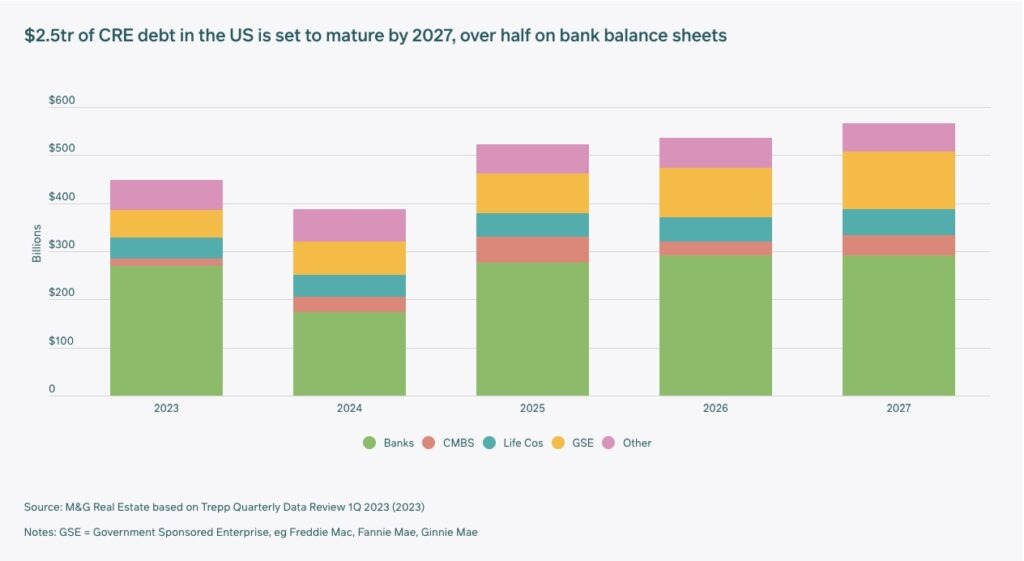
Alternative lenders stepping in as banks retreat
With the banks having significantly less appetite to lend, their retreat provides an opportunity for non-bank lenders, such as real estate debt funds, to step in and provide loans for borrowers who require financing for their real estate investments.
That said, non-bank lenders (NBLs) may see their potential to finance new loans restricted by their existing portfolios. While, in the post-GFC era, tighter regulation has narrowed banks’ focus to lower risk loans, non-bank lenders have been able to capitalise on the demand for financing at much higher LTVs and more limited interest coverage ratios (ICRs). Recent declines in capital values may now expose these lenders to potential covenant breaches, especially on non-core assets where income streams may be under pressure and prospects remain challenging.
Nevertheless, we believe new entrants with fresh capital or without legacy portfolios will be able to take advantage of what could be the most attractive lenders’ market since before the GFC drove borrowing rates down to record lows.
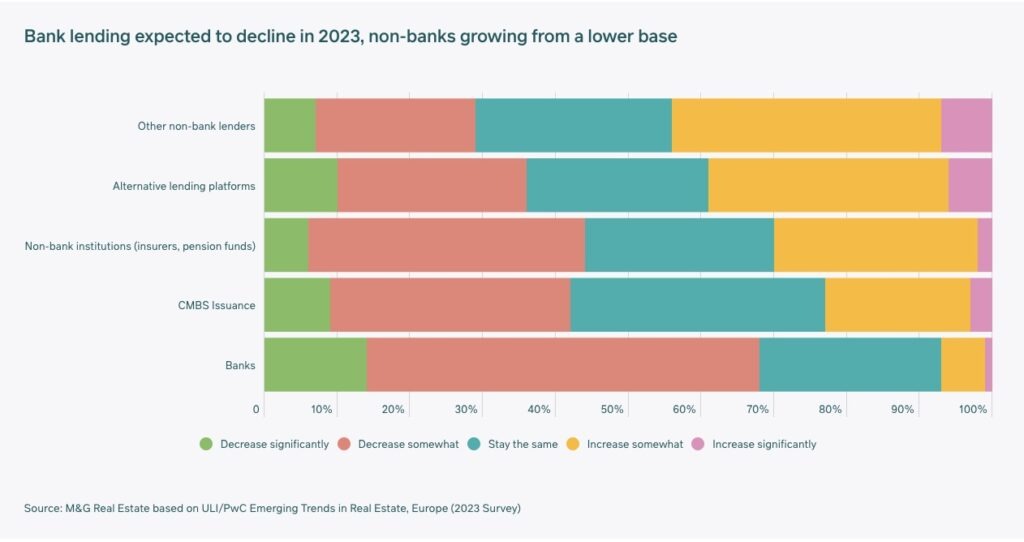
Real estate market vulnerabilities most apparent in the US
As previously mentioned, the US faces a number of headwinds from a property fundamentals perspective as well as lending risk and bank fragility.
The concentration of CRE loan risks within regional banks and the lack of regulatory oversight is particularly concerning. According to Trepp, as at Q4 2022, nearly a quarter of banks with $10-50 billion in assets have exceeded at least one recommended threshold for real estate and construction loans, indicating further difficulties and distressed opportunities that may yet emerge. Balance sheet vulnerabilities could end up having wide economic ramifications.
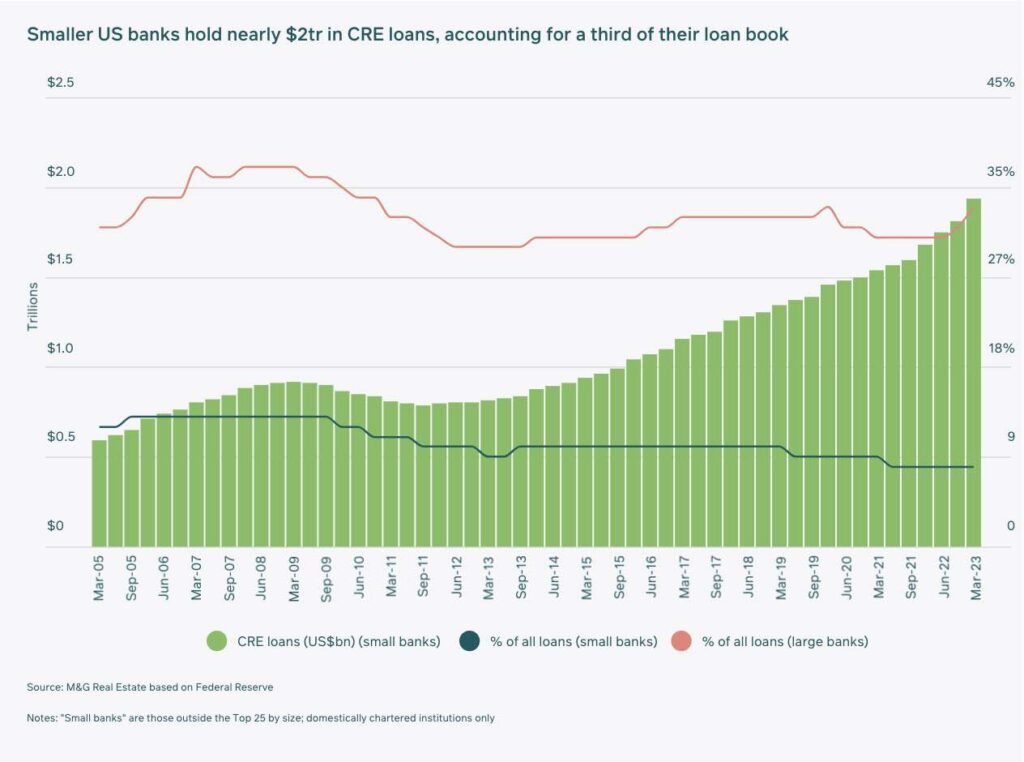
Tightening credit conditions more broadly are likely to have a material impact on the economy and corporate sentiment. A period of higher interest rates has already knocked venture capital (VC) fundraising, with implications on the outlook for office occupiers from San Diego to Boston. For big-tech, a realignment of headcount and more muted growth potential is set to reduce aggregate office demand in select metros. On top of this, more ingrained work-from-home habits post-pandemic across the country suggest office occupancies are unlikely to recover without a fundamental realignment of stock.
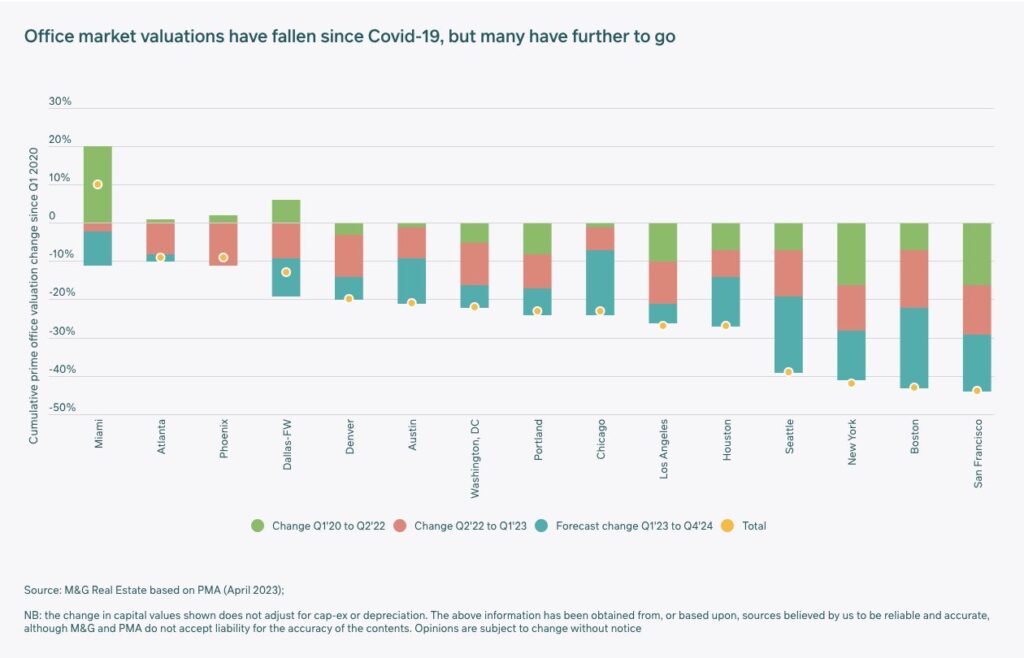
Notwithstanding the cyclical and structural negatives facing the office sector, opportunities may be found in a range of other US real estate segments. The multifamily sector is coming off the back of record rental growth, and while the sector has a record number of units under construction, financial barriers to home ownership will keep any risk of dramatic rental over-supply more limited. A majority of logistics markets across the nation continue to see dwindling availability ratios for space driven by structurally growing e-commerce spend, while alternative sectors such as hotels, life sciences and data centres also offer attractive fundamentals, in our view.
Has UK real estate won the race to the bottom?
Significant increases in policy rates and the disastrous “mini-budget” in October have led to the UK seeing a much starker real estate repricing than elsewhere in the world. Sentiment has been evolving from gloom and doom to burgeoning optimism and values look to be finding a floor, while other global regions are pencilling in further falls, but is this optimism misplaced?
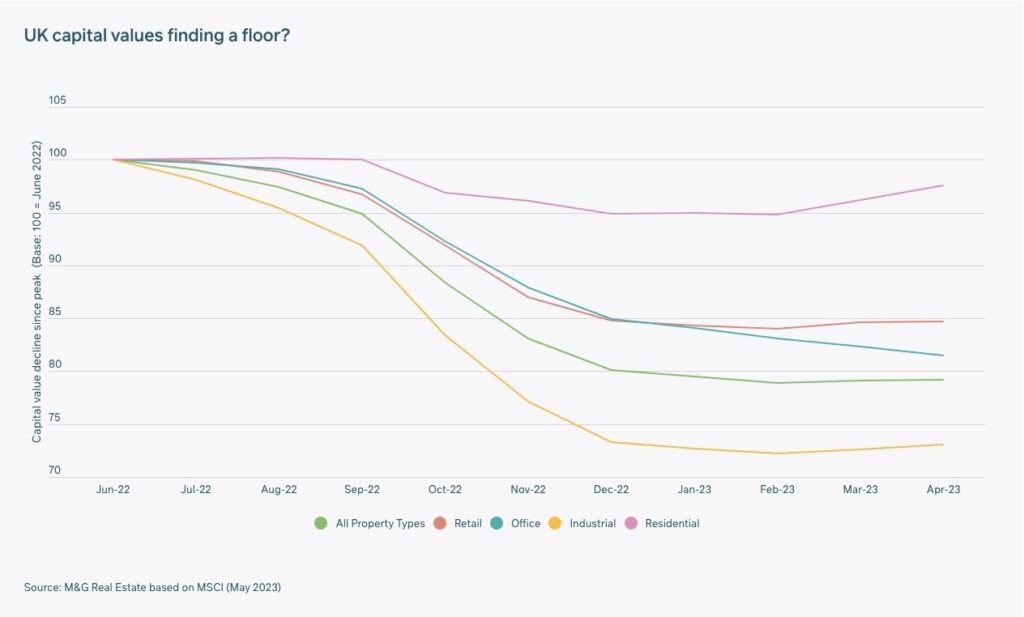
Taking a glass half full view, the UK economy has seemingly swerved a widely-anticipated recession and, while the economic outlook appears muted, sentiment points to growth, supporting occupier demand.
Meanwhile, investor sentiment has also strengthened. Where yields have substantially repriced – with value re-emerging – and there is a strong narrative around long-term viability, notably for multi-let industrials and retail warehouses, there are already early signs of a return to yield compression. The Living sector remains in favour too, supported by a buoyant rental growth outlook, a trait that will be much prized in an environment of high inflation.
Still, ever-present downside risks could mean any optimism is a false dawn. Higher mortgage rates have yet to truly hit household wallets, bringing into question economic recovery potential. UK inflation is also proving stickier than expected, raising concerns of a wage-price spiral that could mean yet more interest rate rises and further public sector strikes. This could tip the scales and push the economy into recession, even though it has so far been averted.
Meanwhile, if debt costs for commercial real estate in the UK rise further – meaning the numbers simply don’t add up – it could be a major roadblock for the asset class’s recovery and potentially lead to renewed falls in capital values across the board. This would particularly be the case for parts of the market that are already under pressure, notably non-core offices or assets that do not meet environmental standards. The potential for further banking volatility poses risks that should not be ignored.
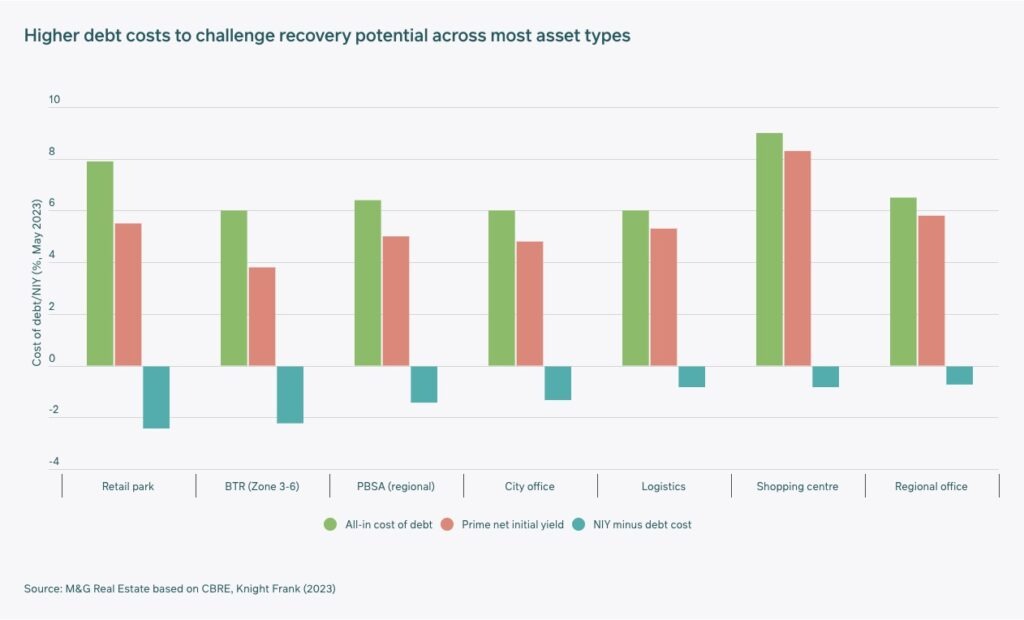
Is the end of the downturn in sight for Europe?
The varied patchwork of European commercial real estate offers both threats and opportunities for investors, with some differences between sector and country outlooks, in our view. Property valuations have been a little slower to adjust than in the UK, but the peak-to-trough capital value change is likely to be lower in aggregate.
Structural elements in the logistics and residential sectors, in particular, remain supportive for strong rental growth moving forward. Elevated demand for good quality assets combined with low supply and future pipeline challenges have created low vacancy rates and the possibility for landlords to capture rising rents.
As ever, location remains key. Vacancy rates in supply-constrained central business district (CBD) office sub-markets, for example, are considerably below wider city levels, giving stronger rental growth prospects.
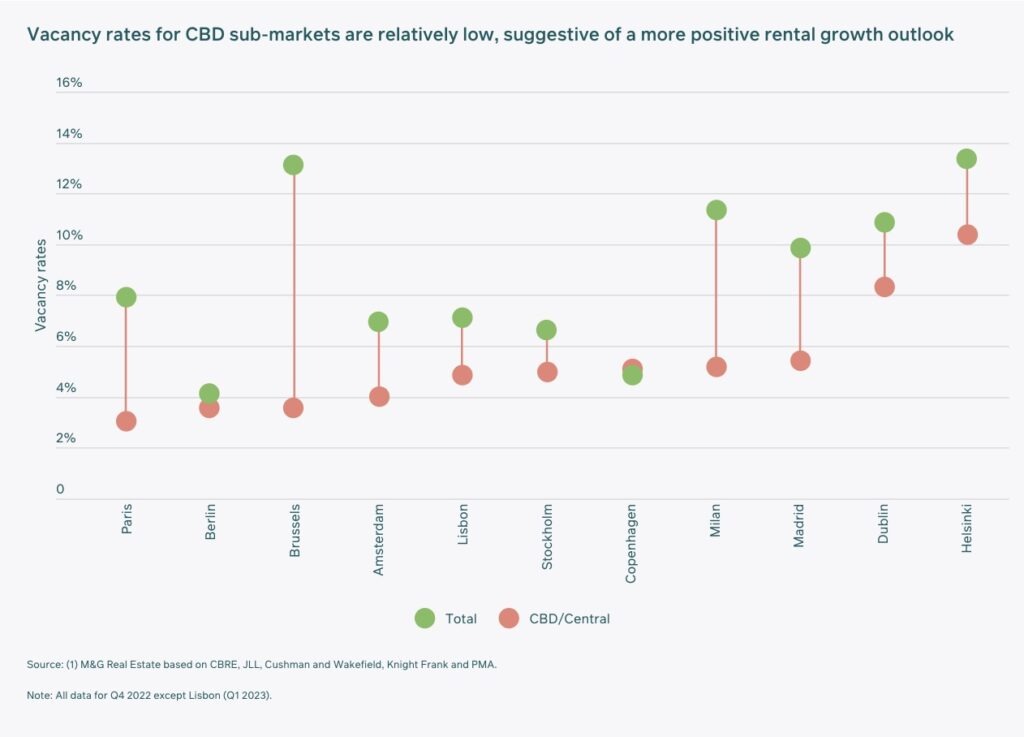
The risks do, however, remain to the downside. Sluggish economic growth, persistent above-target inflation, and higher interest rates are still plausible outcomes that would drag on performance. While the economy continues to surprise on the upside, the risk of a protracted or deep recession for individual markets, or the whole bloc, is still there, which would dampen occupational demand and the rental outlook.
Leverage for the European commercial real estate sector is lower than in the run up to the GFC, but there are still significant refinancing risks for asset owners in the coming years. Some loans have been extended by banks, but materially higher all-in costs of debt will continue to challenge owners. One market which has out-sized risk factors is Sweden, where a number of now large locally-listed companies used high leverage to rapidly expand their portfolios over the last few years. Public markets have reflected these concerns with share prices falling since the start of the year, and wider national economic risks are amplified by a high proportion of variable rate mortgages.
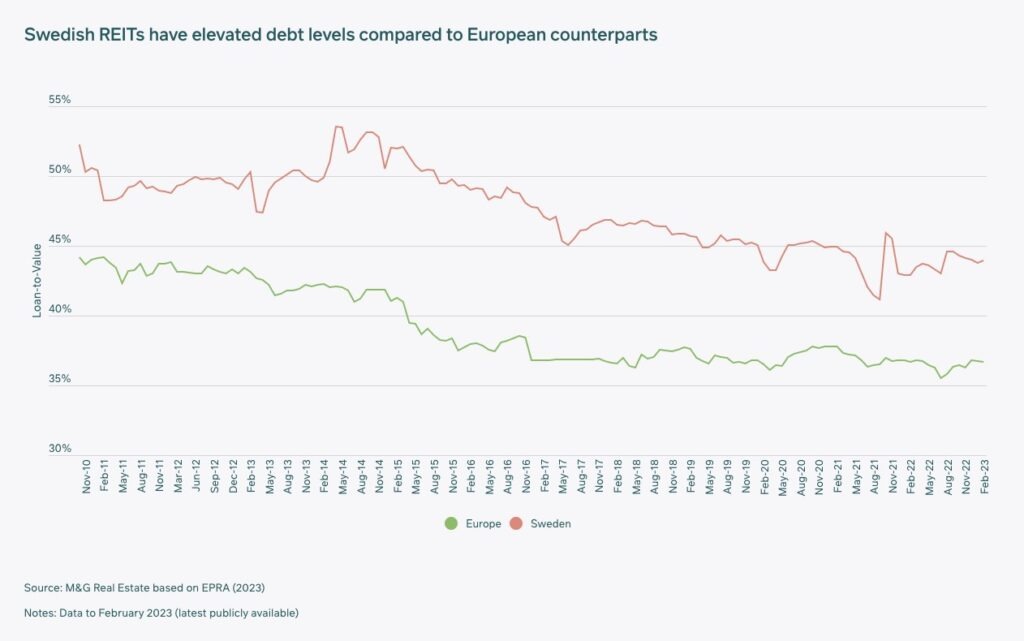
The risks do, however, remain to the downside. Sluggish economic growth, persistent above-target inflation, and higher interest rates are still plausible outcomes that would drag on performance. While the economy continues to surprise on the upside, the risk of a protracted or deep recession for individual markets, or the whole bloc, is still there, which would dampen occupational demand and the rental outlook.
Leverage for the European commercial real estate sector is lower than in the run up to the GFC, but there are still significant refinancing risks for asset owners in the coming years. Some loans have been extended by banks, but materially higher all-in costs of debt will continue to challenge owners. One market which has out-sized risk factors is Sweden, where a number of now large locally-listed companies used high leverage to rapidly expand their portfolios over the last few years. Public markets have reflected these concerns with share prices falling since the start of the year, and wider national economic risks are amplified by a high proportion of variable rate mortgages.
Key takeaways
Low chance of recent banking turmoil escalating into full financial crisis
Despite the pace of the ongoing monetary tightening cycle, the banking sector is in a relatively solid position, at least when compared to the GFC. Stronger existing regulations (especially in Europe), stronger bank balance sheets, more regulatory support, and less risky existing lending are factors defining features of the system’s current resilience.
Not out of the woods yet
The picture is not all positive – stresses and risks are still present in the system. Further issues within the banking sector could flare up, most notably within US mid-tier banks which have outsized exposure to CRE loans. Rising rates may create wider problems in the economy, such as negatively impacting the corporate investment outlook.
Real estate set to have tighter credit conditions for foreseeable future
The most likely path forward is a prolonged period of tighter credit conditions for real estate, negatively impacting valuations and activity in the market. Banks (and non-bank lenders) are already adopting stricter credit conditions (higher margins, lower LTVs) and are focusing only on the best quality loans for new business moving forward.
Correction for property pricing – with more to come for many markets/assets
Real estate markets globally have reacted to rising interest rates and prices have adjusted – sometimes significantly, meaning value has been re-emerging. However, there is likely to be further movement as second-order effects weigh on fundamentals and transaction markets pick up again. The US office sector, with record-high vacancy rates coupling with obsolescence risk, is a major (and consequential) example.
From crisis comes both challenge and opportunity
As the challenges are worked through in the coming quarters, both winners and losers will likely emerge. Some investors may suffer – notably those who have been overleveraged and now face refinancing risks, or those who have been overly exposed to weaker/riskier property – but others should be able to take advantage of great opportunities, such as acquiring mispriced assets.



